EAW WW1 Theatre
Moderator: rotton50
-
rotton50
- Warrant Officer

- Posts: 2991
- Joined: Sun Sep 10, 2006 1:30 pm
- Location: Cape Charles, Virginia, USA
Re: EAW WW1 Theatre
Peter,
I put a 1st attempt Sopwith Camel FM in your folder.
I need you to check:
1 - Speed at sea level, 5000 ft and 15000 ft.
2 - Roll rate at full speed at the same heights, both left and right.
3 - Speed in dives where the plane sustains damage.
4 - Take offs. These are hairy so try Taking off with about 1/2 throttle or a bit more, throttle back as the plane veers to the right, correct with ailerons and then SLOWLY add throttle.
5 - Any other parameters you might think are important.
Thanks
Oh, I almost forgot. Turn engine overheat off. It doesn't work properly for WWI planes and since we're past the stage of editing the exec, it's just going to have to be a note to users.
I put a 1st attempt Sopwith Camel FM in your folder.
I need you to check:
1 - Speed at sea level, 5000 ft and 15000 ft.
2 - Roll rate at full speed at the same heights, both left and right.
3 - Speed in dives where the plane sustains damage.
4 - Take offs. These are hairy so try Taking off with about 1/2 throttle or a bit more, throttle back as the plane veers to the right, correct with ailerons and then SLOWLY add throttle.
5 - Any other parameters you might think are important.
Thanks
Oh, I almost forgot. Turn engine overheat off. It doesn't work properly for WWI planes and since we're past the stage of editing the exec, it's just going to have to be a note to users.
Re: EAW WW1 Theatre
R31 and R32 class
The R31-class included two British rigid airships, R31 and R32, built in 1918 with wooden frames due to wartime shortages of duralumin.

R32 Class
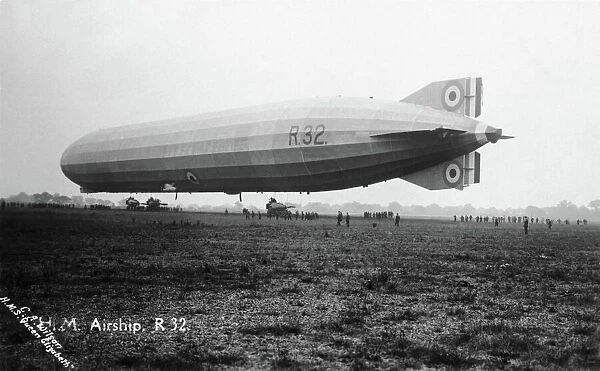
In case there is interest and not only Germans can have this type of airships.
If there is interest, I can make a small list with images of many other medium and even small airships that were there.
The R31-class included two British rigid airships, R31 and R32, built in 1918 with wooden frames due to wartime shortages of duralumin.
- R31 was deployed for naval patrols and convoy escort duties. It was stationed at East Fortune in Scotland but suffered severe water damage while moored in bad weather. The moisture warped its wooden structure, making it unsafe to fly. It was decommissioned and scrapped shortly after the war ended.
- R32had a longer postwar career. It was used for training and experimental missions, including aircraft interception trials and docking experiments. Despite its innovative use, the wooden frame remained vulnerable to environmental damage. R32 was retired and dismantled in the early 1920s.

R32 Class

In case there is interest and not only Germans can have this type of airships.
If there is interest, I can make a small list with images of many other medium and even small airships that were there.
-
rotton50
- Warrant Officer

- Posts: 2991
- Joined: Sun Sep 10, 2006 1:30 pm
- Location: Cape Charles, Virginia, USA
Re: EAW WW1 Theatre
Right now there's only one model but it is easy to resize it and then reskin it to represent an allied airship.
-
Moggy
- Site Admin

- Posts: 4531
- Joined: Tue Feb 03, 2004 12:52 am
- Location: A slit trench near RAF Gravesend
- Contact:
-
rotton50
- Warrant Officer

- Posts: 2991
- Joined: Sun Sep 10, 2006 1:30 pm
- Location: Cape Charles, Virginia, USA
Re: EAW WW1 Theatre
Ok, thanks.
Oh also, I added the Airco DH4 to the mix. Didn't take much because I was able to mix and match previous sections from other models and make relatively minor adjustments.
Fuselage from the SE5a, Prop from the RE8, wings from the Aviatek C2 and tail from the Breguet. Changed the skins a bit and ta-da, another plane.
I'll add it to the Allied planes zip file and upload it along with the German plane models zip tomorrow.
Oh also, I added the Airco DH4 to the mix. Didn't take much because I was able to mix and match previous sections from other models and make relatively minor adjustments.
Fuselage from the SE5a, Prop from the RE8, wings from the Aviatek C2 and tail from the Breguet. Changed the skins a bit and ta-da, another plane.
I'll add it to the Allied planes zip file and upload it along with the German plane models zip tomorrow.
-
rotton50
- Warrant Officer

- Posts: 2991
- Joined: Sun Sep 10, 2006 1:30 pm
- Location: Cape Charles, Virginia, USA
Re: EAW WW1 Theatre
Found a couple of major R/S issues with the first attempt so I had to go back and make some changes.
Here's the Airco DH4:
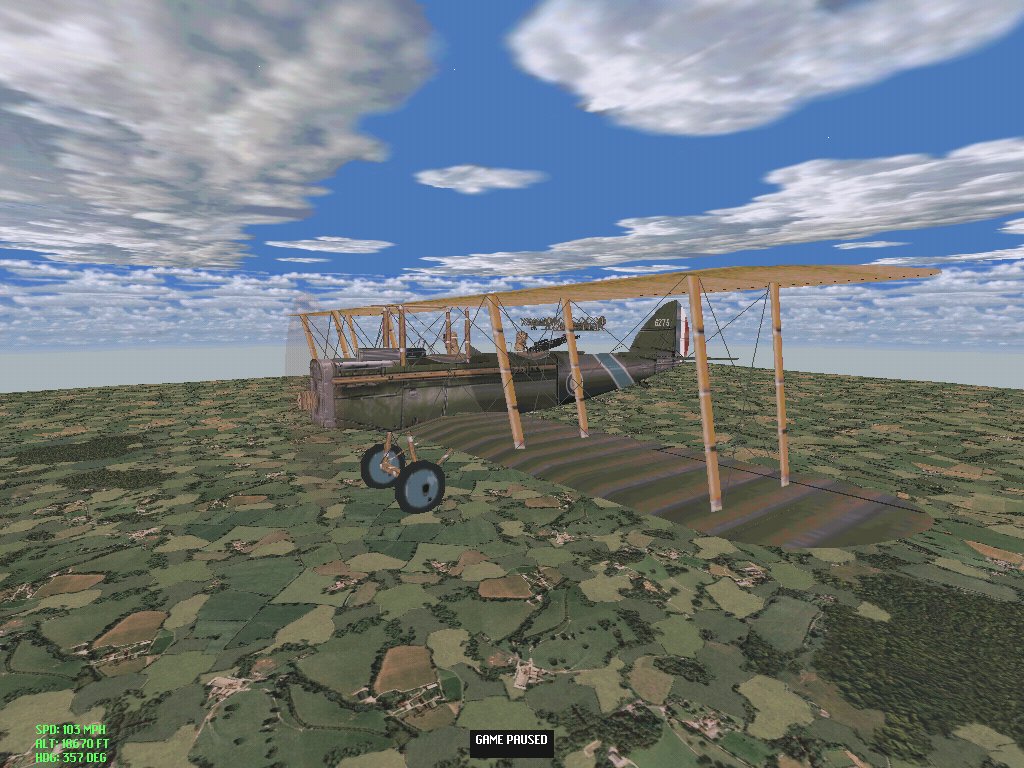
Also, I found a treasure trove of less well know WWI aircraft including drawings and flight data so once the basics are taken care of I'll continue to work on adding new planes.
I'll upload both new Allied and German plane sets today. Just models for now, no FM's until I hear back from you.
Here's the Airco DH4:

Also, I found a treasure trove of less well know WWI aircraft including drawings and flight data so once the basics are taken care of I'll continue to work on adding new planes.
I'll upload both new Allied and German plane sets today. Just models for now, no FM's until I hear back from you.
Re: EAW WW1 Theatre
I know of an iconic and interesting airplane that doesn't appear much in the media:
The Etrich Taube
The Etrich Taube was a pioneering monoplane aircraft designed by Austrian engineer Igo Etrich in 1909. Its shape was inspired by the tropical Zanonia seed, which glides naturally through the air. The name “Taube,” meaning “dove” in German, reflected its birdlike appearance, with curved wings and a fan-shaped tail that gave it excellent stability in flight.
The first successful flight took place in 1910. Although Etrich built the initial models, he later transferred production rights to Rumpler, a German manufacturer who mass-produced the aircraft. Other companies like Aviatik, Lohner, and Jeannin also built their own versions. The Taube was constructed from wood and fabric, with a wingspan of about 13 meters, a length of 9 meters, and an empty weight around 500 kilograms. It was powered by engines ranging from 70 to 100 horsepower, such as the Argus As I or Mercedes D.I, reaching speeds up to 100 kilometers per hour and flight durations over an hour.
Flight control was achieved through wing warping, a method used before the invention of ailerons. The fixed landing gear had simple wheels, and the aircraft was known for its excellent stability, though it lacked agility. In 1911, Italian pilot Giulio Gavotti made history by dropping the first aerial bomb from a Taube over Libya, marking the beginning of air warfare. The aircraft was soon adopted by Germany, Austria-Hungary, Italy, and even the British Royal Naval Air Service.
At the outbreak of World War I in 1914, the Taube was deployed for reconnaissance missions, thanks to its steady flight and visibility from above. However, it quickly became outdated as faster and more maneuverable aircraft entered the battlefield.
Photo of the device

Diagram

Paintings


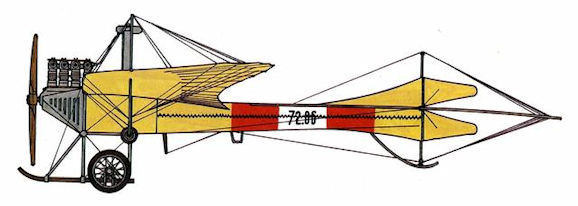
Etrich Taube Variants
1. Etrich Taube
The original design by Igo Etrich, featuring wing warping and a dove-like silhouette. Used mainly for reconnaissance and training.
2. Rumpler Taube
Mass-produced version by Rumpler, the most widely used in Germany. Included structural reinforcements and more powerful engines.
3. Jeannin Stahltaube
A German variant with a steel-tube fuselage, offering greater durability than the original wooden frame.
4. Aviatik Taube
Built by Aviatik with slight modifications to the wing shape and control surfaces for improved handling.
5. Lohner Taube
Produced in Austria-Hungary, closely followed the original Etrich design. Used primarily for training and observation.
6. Albatros Taube
Adapted for light bombing missions, featuring aerodynamic improvements and structural tweaks.
7. Etrich Taube II
A refined version with better flight characteristics and structural updates, used by the Austro-Hungarian military.
8. Doppeltaube
An experimental twin-fuselage version designed for testing purposes. Rare and not widely adopted.
9. Etrich-Rumpler Taube
A transitional model bridging Etrich’s original design and Rumpler’s production line, combining features from both.
The Etrich Taube
The Etrich Taube was a pioneering monoplane aircraft designed by Austrian engineer Igo Etrich in 1909. Its shape was inspired by the tropical Zanonia seed, which glides naturally through the air. The name “Taube,” meaning “dove” in German, reflected its birdlike appearance, with curved wings and a fan-shaped tail that gave it excellent stability in flight.
The first successful flight took place in 1910. Although Etrich built the initial models, he later transferred production rights to Rumpler, a German manufacturer who mass-produced the aircraft. Other companies like Aviatik, Lohner, and Jeannin also built their own versions. The Taube was constructed from wood and fabric, with a wingspan of about 13 meters, a length of 9 meters, and an empty weight around 500 kilograms. It was powered by engines ranging from 70 to 100 horsepower, such as the Argus As I or Mercedes D.I, reaching speeds up to 100 kilometers per hour and flight durations over an hour.
Flight control was achieved through wing warping, a method used before the invention of ailerons. The fixed landing gear had simple wheels, and the aircraft was known for its excellent stability, though it lacked agility. In 1911, Italian pilot Giulio Gavotti made history by dropping the first aerial bomb from a Taube over Libya, marking the beginning of air warfare. The aircraft was soon adopted by Germany, Austria-Hungary, Italy, and even the British Royal Naval Air Service.
At the outbreak of World War I in 1914, the Taube was deployed for reconnaissance missions, thanks to its steady flight and visibility from above. However, it quickly became outdated as faster and more maneuverable aircraft entered the battlefield.
Photo of the device

Diagram

Paintings



Etrich Taube Variants
1. Etrich Taube
The original design by Igo Etrich, featuring wing warping and a dove-like silhouette. Used mainly for reconnaissance and training.
2. Rumpler Taube
Mass-produced version by Rumpler, the most widely used in Germany. Included structural reinforcements and more powerful engines.
3. Jeannin Stahltaube
A German variant with a steel-tube fuselage, offering greater durability than the original wooden frame.
4. Aviatik Taube
Built by Aviatik with slight modifications to the wing shape and control surfaces for improved handling.
5. Lohner Taube
Produced in Austria-Hungary, closely followed the original Etrich design. Used primarily for training and observation.
6. Albatros Taube
Adapted for light bombing missions, featuring aerodynamic improvements and structural tweaks.
7. Etrich Taube II
A refined version with better flight characteristics and structural updates, used by the Austro-Hungarian military.
8. Doppeltaube
An experimental twin-fuselage version designed for testing purposes. Rare and not widely adopted.
9. Etrich-Rumpler Taube
A transitional model bridging Etrich’s original design and Rumpler’s production line, combining features from both.
-
rotton50
- Warrant Officer

- Posts: 2991
- Joined: Sun Sep 10, 2006 1:30 pm
- Location: Cape Charles, Virginia, USA
Re: EAW WW1 Theatre
Off topic but important for anyone still interested in EAW.
I saw where FsFoot had a lengthy screed over on SimHQ about the Code Group.
A couple of things:
1 - Moggy's reply was short and sweet, totally debunking the idea the Code Group, Mr. Jelly in particular, act like we think we're owners of the code. It needs no further explanation.
2 - This screed is jealousy personified. FsFoot quite literally will tell you (you can look up prior conversations if so inclined)) that he is the smartest guy in the room, yet he hasn't contributed one damn thing to this game in over 15 years. Actions speak louder than words.
3 - When you read his posts keep in mind the old adage "if you can't blind them with brilliance, baffle them with bullshit".
That is all.
Now back to the subject at hand.
I've uploaded a new set of models, both Allied and German. However, as I start working on FM's I've found a few small errors in some of the models, like incorrect shadow files. Nothing major but I am a bit anal on these things, so the model sets will need to be uploaded again once I go through all the planes.
I've got some good FM's going on the inline engine planes. They're a lot easier to do than the rotary engine ones. So until Moggy gets back to me with some feed back on the Camel I'm going to keep working on those.
I saw where FsFoot had a lengthy screed over on SimHQ about the Code Group.
A couple of things:
1 - Moggy's reply was short and sweet, totally debunking the idea the Code Group, Mr. Jelly in particular, act like we think we're owners of the code. It needs no further explanation.
2 - This screed is jealousy personified. FsFoot quite literally will tell you (you can look up prior conversations if so inclined)) that he is the smartest guy in the room, yet he hasn't contributed one damn thing to this game in over 15 years. Actions speak louder than words.
3 - When you read his posts keep in mind the old adage "if you can't blind them with brilliance, baffle them with bullshit".
That is all.
Now back to the subject at hand.
I've uploaded a new set of models, both Allied and German. However, as I start working on FM's I've found a few small errors in some of the models, like incorrect shadow files. Nothing major but I am a bit anal on these things, so the model sets will need to be uploaded again once I go through all the planes.
I've got some good FM's going on the inline engine planes. They're a lot easier to do than the rotary engine ones. So until Moggy gets back to me with some feed back on the Camel I'm going to keep working on those.
-
Moggy
- Site Admin

- Posts: 4531
- Joined: Tue Feb 03, 2004 12:52 am
- Location: A slit trench near RAF Gravesend
- Contact:
Re: EAW WW1 Theatre
Yeh. I thought I should say something in response to fsfoot's screed.
I'll try and get down to those FMs in this coming week.
I'll try and get down to those FMs in this coming week.
Moggy
www.mogggy.org
www.mogggy.org
-
Moggy
- Site Admin

- Posts: 4531
- Joined: Tue Feb 03, 2004 12:52 am
- Location: A slit trench near RAF Gravesend
- Contact:
Re: EAW WW1 Theatre
I have finally got airborne with Ray's new WW1 planeset.
However there are some missing skinfiles. From the Camel, the planeTES.tpc, and from the Albatross CIII plane01tra.tpc and plane02tra.tpc.
And maybe glitch in the Camel cockpit?
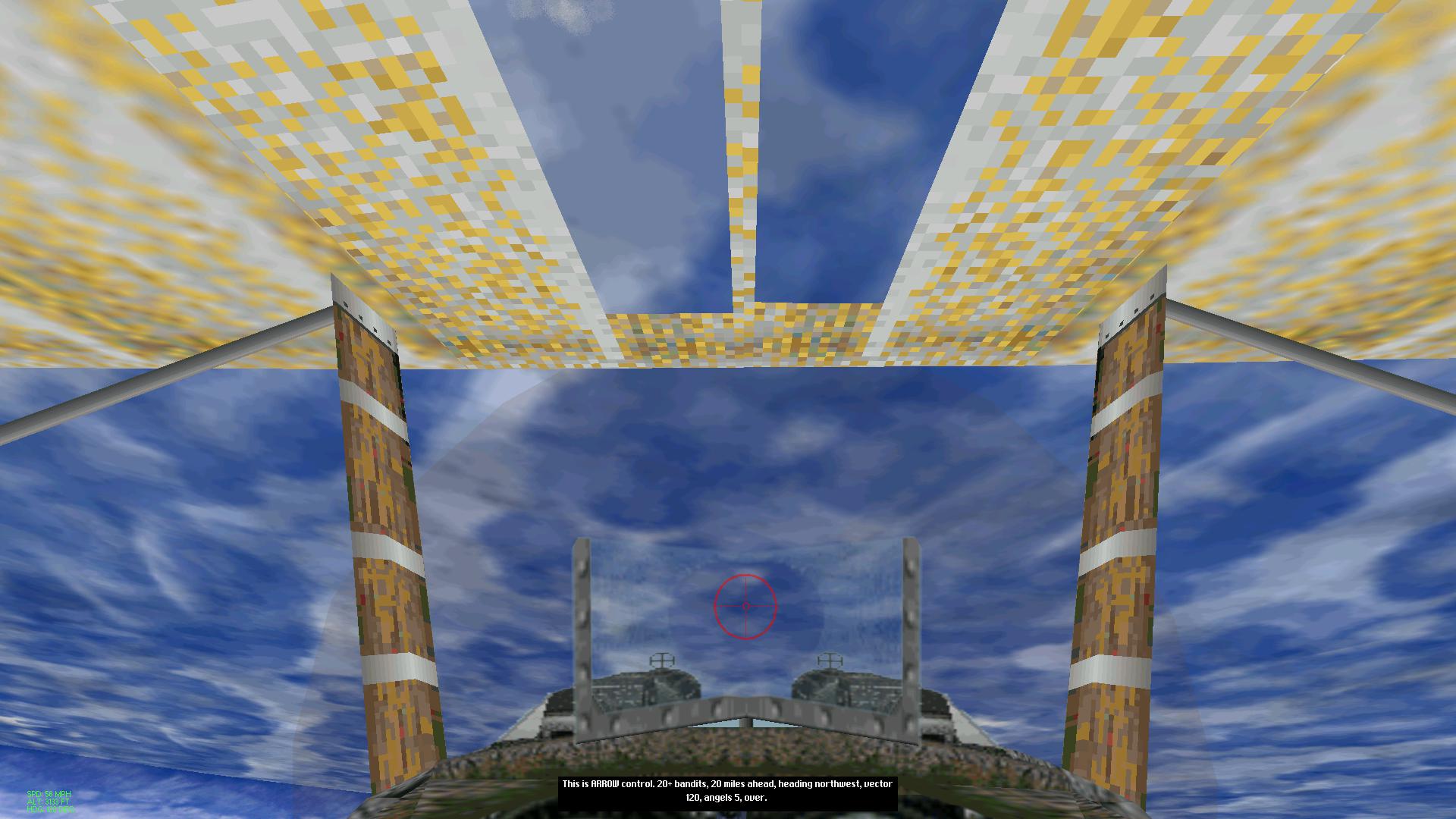
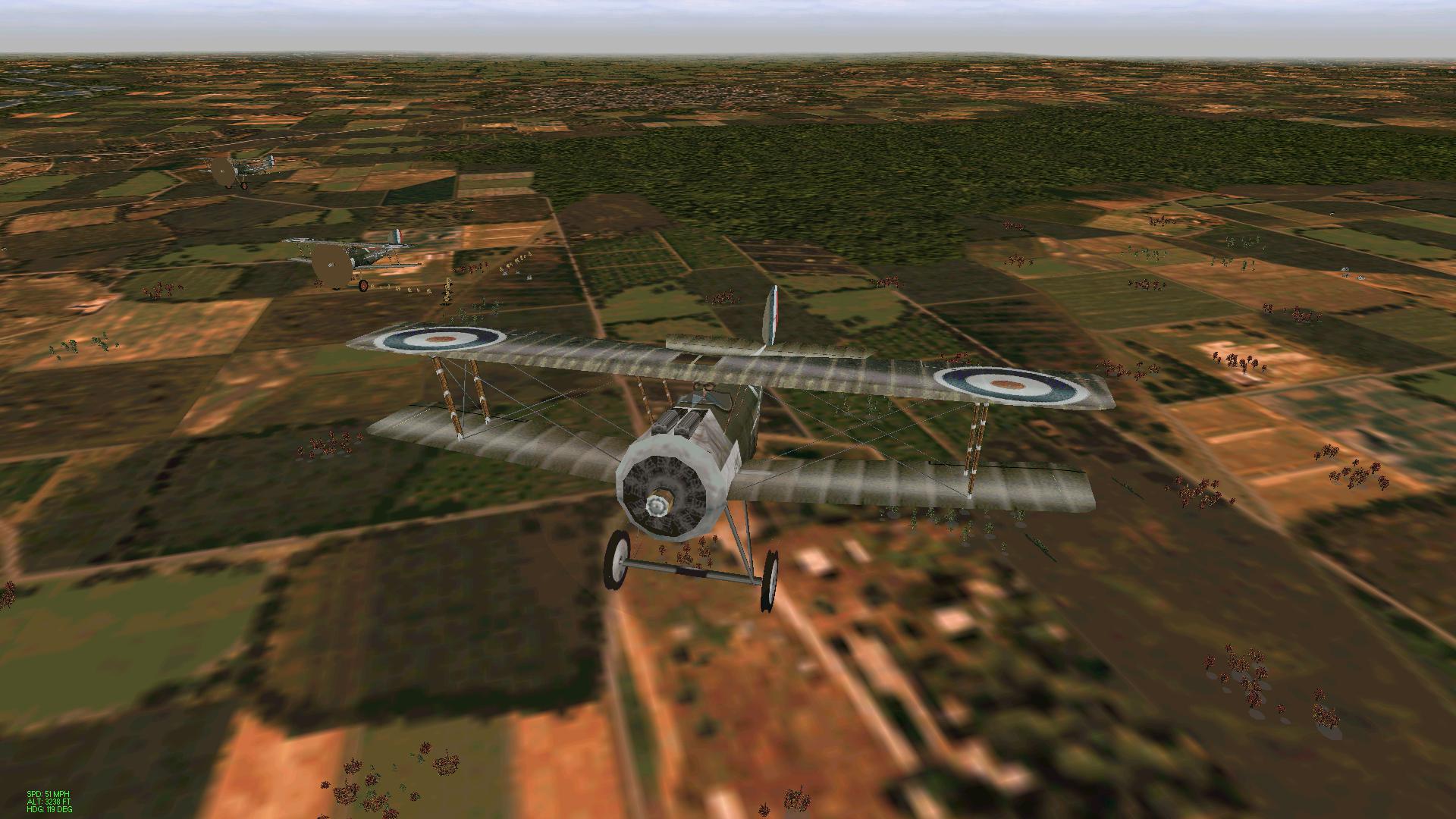
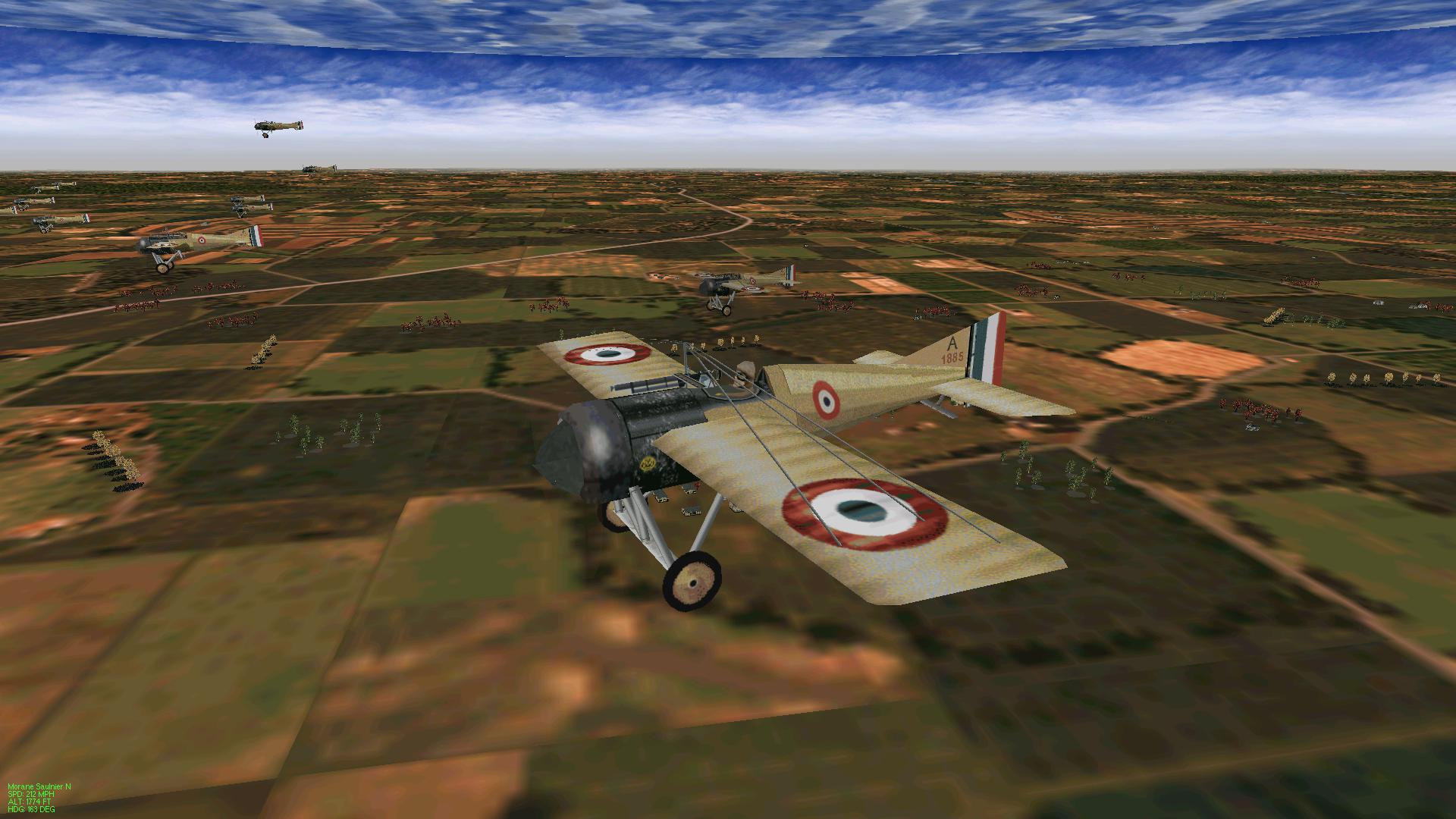
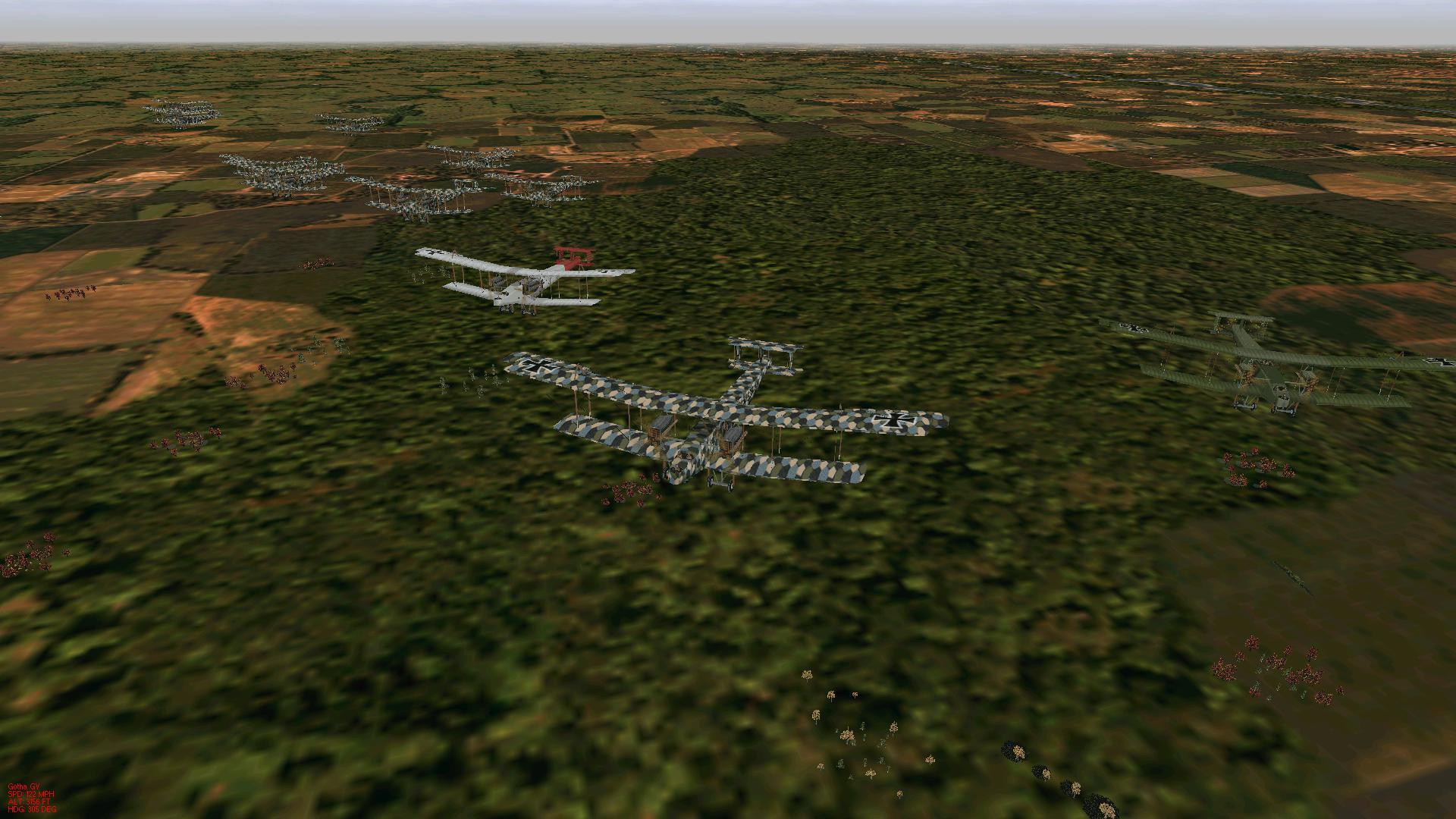
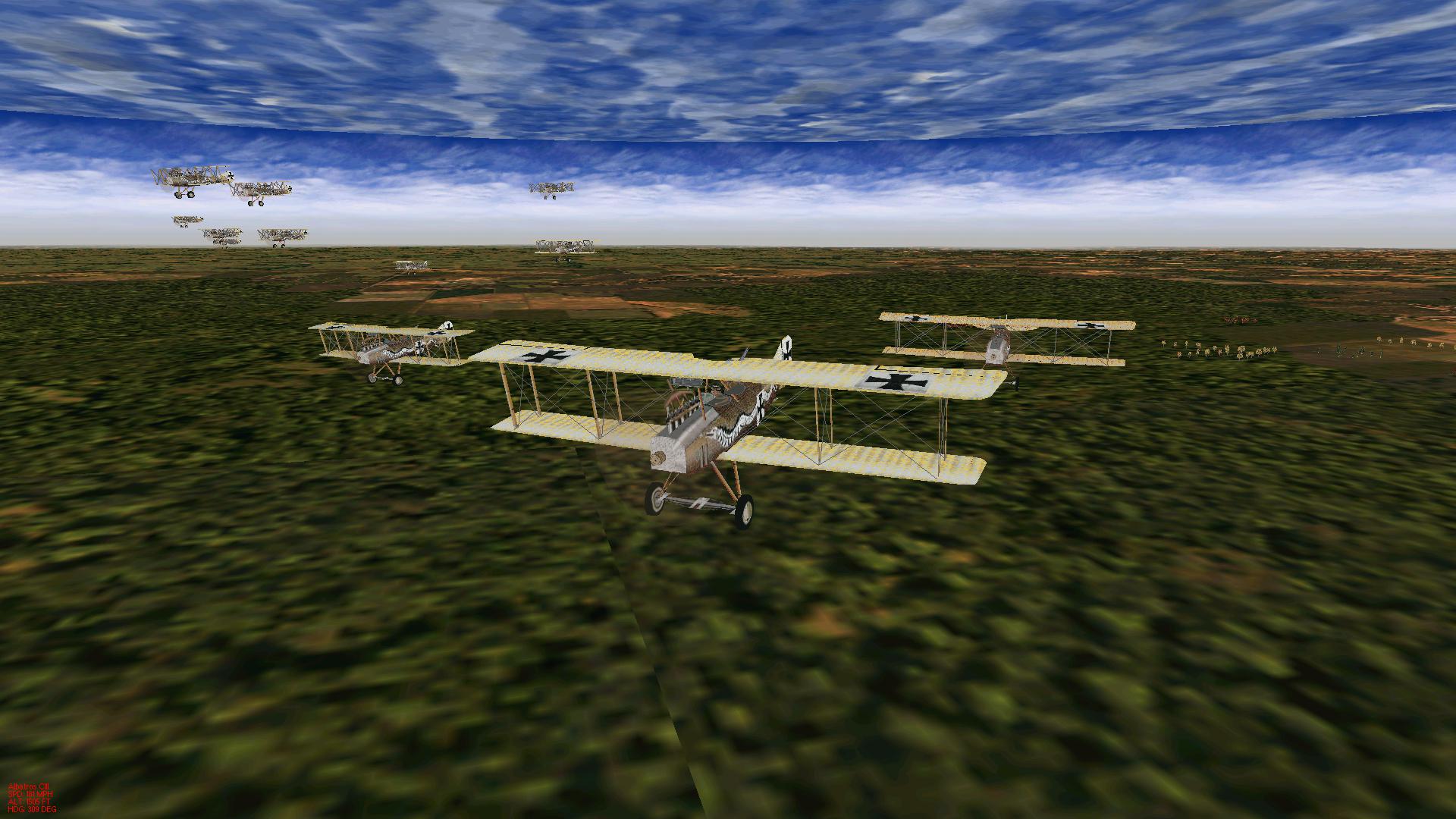
I'll have a go at testing the Camel FM soonest.
However there are some missing skinfiles. From the Camel, the planeTES.tpc, and from the Albatross CIII plane01tra.tpc and plane02tra.tpc.
And maybe glitch in the Camel cockpit?





I'll have a go at testing the Camel FM soonest.
Moggy
www.mogggy.org
www.mogggy.org
-
Moggy
- Site Admin

- Posts: 4531
- Joined: Tue Feb 03, 2004 12:52 am
- Location: A slit trench near RAF Gravesend
- Contact:
Re: EAW WW1 Theatre
Some first results:
But first - what version of the 1.6 exe are you using? Violent tendency to roll right, especially with most recent exe. Reverted to V32 and seemed less violent.
Generally the tendency to roll right is strong. Can correct with wing leveller when not in combat. Shame we don't have trim adjustments.
But first - what version of the 1.6 exe are you using? Violent tendency to roll right, especially with most recent exe. Reverted to V32 and seemed less violent.
NotedTurn engine overheat off.
Very hairy. Using some tough aileron did get off.4 - Take offs. These are hairy so try Taking off with about 1/2 throttle or a bit more, throttle back as the plane veers to the right, correct with ailerons and then SLOWLY add throttle.
At sea level with max throttle about 115-120 mph. At 5,000 ft not a great deal of difference. 15,000 still to do.1 - Speed at sea level, 5000 ft and 15000 ft.
Still to do.2 - Roll rate at full speed at the same heights, both left and right.
3 - Speed in dives where the plane sustains damage.
5 - Any other parameters you might think are important.
Generally the tendency to roll right is strong. Can correct with wing leveller when not in combat. Shame we don't have trim adjustments.
Moggy
www.mogggy.org
www.mogggy.org
-
rotton50
- Warrant Officer

- Posts: 2991
- Joined: Sun Sep 10, 2006 1:30 pm
- Location: Cape Charles, Virginia, USA
Re: EAW WW1 Theatre
1 - I've been playing around a bit with the Camel FM so it's not quite so violent but the drift to the right is still there. From my readings it seems the plane always required joysick input to remain in level flight. I suppose if a player gets tired of this propensity they could turn off the torque effect in the difficulty section of the game setup.
2 - I noticed the problem with the Camel's cockpit and have fixed it but I'll have to check on the missing files.
3 - It seems the rotary engined planes did not have much difference in speed at low to mid altitudes but fell off rapidly at high altitudes. I've amended the FM's to reflect that.
4 - I've almost finished a preliminary set of FM's for the Allied planes and will shortly upload them to the server. I took a little detour when I found out there was a Fokker D VI. Basically a Dr1 with the wings from the D VII. Pretty easy addition.
5- The hardest FM to do was the HP-400. Not easy to get that lumbering giant to take off and fly in a reliable manner but I think I've got it.
6 - I was pleasantly surprised to find a 90% complete FM for the SE5a done by AngleOff. None of the other ones I tried were even close to correct but this one was good except for the damage points and small stuff like range and fuel load.
7 - On the subject of damage points I have to make a compromise of sorts. I want the wings to be as fragile as real life reports so I set the damage points very low. If you dive any of the planes at over 200 MPH and try to pull out abruptly the wings will collapse. The problem is, in a dogfight one quick shot will also destroy the wings. My bodge is to set the hit bubble size to the smallest possible number thus making it unlikely you can take down an enemy by hitting the wings. We'll have to see if this works as intended. In fact, it's possible ALL the damage points are too low as I'm in uncharted waters but testing will reveal all.
2 - I noticed the problem with the Camel's cockpit and have fixed it but I'll have to check on the missing files.
3 - It seems the rotary engined planes did not have much difference in speed at low to mid altitudes but fell off rapidly at high altitudes. I've amended the FM's to reflect that.
4 - I've almost finished a preliminary set of FM's for the Allied planes and will shortly upload them to the server. I took a little detour when I found out there was a Fokker D VI. Basically a Dr1 with the wings from the D VII. Pretty easy addition.
5- The hardest FM to do was the HP-400. Not easy to get that lumbering giant to take off and fly in a reliable manner but I think I've got it.
6 - I was pleasantly surprised to find a 90% complete FM for the SE5a done by AngleOff. None of the other ones I tried were even close to correct but this one was good except for the damage points and small stuff like range and fuel load.
7 - On the subject of damage points I have to make a compromise of sorts. I want the wings to be as fragile as real life reports so I set the damage points very low. If you dive any of the planes at over 200 MPH and try to pull out abruptly the wings will collapse. The problem is, in a dogfight one quick shot will also destroy the wings. My bodge is to set the hit bubble size to the smallest possible number thus making it unlikely you can take down an enemy by hitting the wings. We'll have to see if this works as intended. In fact, it's possible ALL the damage points are too low as I'm in uncharted waters but testing will reveal all.
